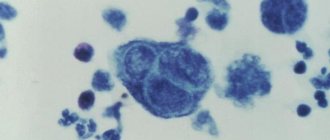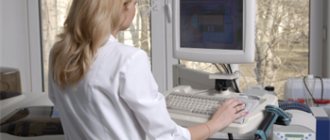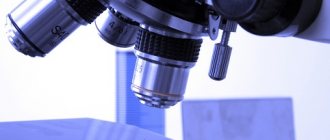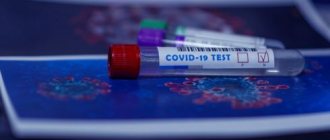Diphtheria
Whooping cough
Colpitis
Thrush
Fungus
21451 03 November
IMPORTANT!
The information in this section cannot be used for self-diagnosis and self-treatment.
In case of pain or other exacerbation of the disease, diagnostic tests should be prescribed only by the attending physician. To make a diagnosis and properly prescribe treatment, you should contact your doctor. We remind you that independent interpretation of the results is unacceptable; the information below is for reference only.
: indications for use, rules for preparing for the test, interpretation of the results and normal indicators.
general characteristics
Discharge from the urethra is examined to diagnose the inflammatory process in urethritis of various etiologies (bacterial urethritis, gonorrhea, trichomoniasis, chlamydia, etc.). When examining discharge from the urethra, the number and composition of cellular elements depend on the severity and duration of the inflammatory process. The inflammatory state of the mucous membrane of the urethra (urethra) is expressed by the presence of more than 4 polynuclear neutrophils in the field of view. The depth of the pathological process in the urethra is evidenced by the predominance of columnar and parabasal epithelium in the preparations.
Urological smear
The patient lowers his trousers and underwear slightly. The specialist who takes the smear first cleans the outlet of the urethra with a sterile napkin, and then proceeds to collect the material. If the discharge is scanty, the patient is asked to massage the penis with gentle movements from top to bottom.
A urological smear is taken from the mucous membrane of the urethra in men with a special sterile probe (brush, cotton swab). It is carefully inserted approximately 3-4 cm into the urethral canal. In this case, the patient may experience minor pain or discomfort.
After collecting the material, the patient often feels a slight tingling in the urethra, itching and pain during urination. These phenomena usually go away during the day. To relieve unpleasant symptoms, doctors recommend drinking plenty of fluids and temporarily eliminating foods and drinks from the diet that can irritate the urethra (smoked meats, spicy foods, seasonings, alcohol, coffee).
The resulting biomaterial is applied to a glass slide and dried. Then it is sent for microscopic examination to the laboratory.
In the laboratory, the smear is dried and stained with Gram, after which it is examined under a microscope (light or electron).
When an infectious pathology is detected, PCR diagnostics of the pathogen .
Decoding the analysis results
Only a doctor should interpret the results.
You should not do this yourself. After all, the specialist evaluates the analysis taking into account the clinical picture, patient complaints and data from other laboratory and instrumental diagnostic methods. In addition, he may prescribe an additional examination if the results obtained do not make it possible to make a final diagnosis. Normal urological smear values and possible deviations are presented in the table.
Table 1. Reference values and deviations of the urological smear.
| № | Index | Norma, p/zr | Possible violations |
| 1. | Leukocytes | up to 5 | They increase during the inflammatory process, prostatitis . |
| 2. | Red blood cells | 0-1 | A large amount can be detected during infectious processes of the genitourinary system . |
| 3. | Epithelial cells (flat and columnar) | to 10 | Their number increases during the inflammatory process. |
| 4. | Slime | absence or insignificant amount | Appears in large quantities during inflammation. |
| 5. | Coccal microflora | moderate amount | Entirely in the field of view may be due to urethritis . |
| 6. | Gonococci | absence | Their presence indicates the presence of gonorrhea . |
| 7. | Trichomonas | absence | The detection speaks of trichomoniasis. |
| 8. | Chlamydia | absence | The presence indicates chlamydia . |
| 9. | Ureaplasma | absence | This indicates the presence of ureaplasmosis. |
| 10. | Fungal flora | absence | Infection with fungi of the genus Candida indicates the presence of candidiasis . |
The number and composition of cellular elements depends on the severity and duration of the inflammatory process.
Deviations in the results of a urological smear serve as an indication for an in-depth medical examination and additional examination. If symptoms of the inflammatory process appear, you cannot treat yourself. This can lead to difficulties in diagnosis and the development of serious complications.
Patient preparation rules
In men: from the urethra. Standard conditions:
During the working day DC.
Important:
During the day before collecting the material, do not use topical medications and refrain from urinating for 2 hours.
Possible:
deviations from standard conditions in agreement with the doctor.
You can add this study to your cart on this page
Preparation for the procedure
The urethra is an organ that is flushed with urine. Typically, epithelium, white blood cells, microorganisms and pathogens are washed out from the surface of the urethra during urination, and after a few hours their number is restored. Therefore, in order for the examination results to be as accurate as possible, the patient is recommended:
- do not urinate for 3–4 hours before taking a smear;
- Do not take antibacterial drugs and antiseptics before going to the doctor.
We employ doctors with over 15 years of experience, candidates and doctors of science. Diagnostic studies are carried out using expert-class devices from international brands (Sonoscape, Pinkview-AT). We also perform urgent examinations, and a doctor can visit your home. At the clinic, you will undergo a comprehensive examination in 1 day.
Interpretation:
- leukocytes (neutrophils and lymphocytes): fresh urethritis or exacerbation of chronic urethritis; eosinophils (over 5-10%) - allergic urethritis; epithelial cells (with a small number of leukocytes): chronic urethritis with epithelial metaplasia (desquamative urethritis) or urethral leukoplakia; red blood cells ( with leukocytes and epithelial cells): traumatic urethritis, urethral tumor, crystalluria, ulceration of the mucous membrane, etc.; lipoid granules: prostatorrhea; spermatozoa: spermatorrhea; mucus without formed elements: urethrorrhea; accumulations of small polymorphic rods on epithelial cells (key cells) with a small number of polynuclear neutrophils: urethritis caused by Corynebacterium vaginale; key cells, bacteria, single polynuclear neutrophils: bacterorrhea.
Sample result (PDF)
What is the procedure for taking a smear?
A smear is taken from men using a special probe or a cotton swab, which is inserted deep enough into the urethra. The patient often experiences quite unpleasant and even painful sensations. Burning and pain in the head of the penis may persist for several hours after the procedure. The material obtained using the probe is applied to a glass slide for microscopic examination. Part of the material is sent for PCR diagnostics, which makes it possible to determine the exact type of pathogen if the patient has an infectious disease.
Types of tests for infections
Depending on the purpose and technique of the study, a man may be prescribed:
- taking a general smear on the flora;
- analysis for genitourinary infections.
The first type of study is used to determine the composition of the microflora in the urethra, as well as the number of leukocytes and other cells in the biomaterial. To do this, a doctor or nurse uses a special sterile probe to take biological material from the urethra and apply it to a glass slide with a thin ball. Then the biomaterial is stained and examined under a microscope. The disadvantage of this analysis is the ability to detect the presence of an infection, but not its causative agent, since many microorganisms in the biomaterial look similar. For a more accurate diagnosis, doctors prescribe a smear for a hidden infection.
To identify the causative agent of an infectious disease, biological material is also taken from the urethra, but is placed not on a glass slide, but in a sterile nutrient medium for growing bacterial cultures. The study involves the use of polymerase chain reaction techniques, which can show the presence of even a small amount of DNA from pathogenic microorganisms.
Using the analysis, it is possible to identify even an asymptomatic infection in which a man is only a carrier. The results of a smear can be qualitative (showing only the presence or absence of an infectious agent) or quantitative (allowing you to count the number of harmful microorganisms).
How to take a smear from men for infection

For the examination to be as accurate as possible, it is necessary to prevent the penetration of microorganisms from the surface of the skin into the biomaterial taken from the urethra. To do this, before taking a smear, doctors suggest removing microflora from the head of the penis by cleansing the skin with soap and water. Then the penis is treated with an isotonic aqueous solution of sodium chloride and dried with a sterile cloth.
To collect biological material, a urogenital probe is carefully inserted into the urethra a few centimeters. Using gentle but intense rotational movements, the doctor ensures that the required amount of biomaterial is taken for the study.
After removing the probe, the biomaterial is spread in a thin layer onto a clean glass slide, which is sent to the laboratory. When checking for sexually transmitted infections, it is transported in a container filled with a special medium.
Many men are afraid of the procedure for collecting biomaterial because they are afraid of pain. Patients who have already undergone this test say that the manipulation causes slight discomfort and almost no pain. The degree of discomfort or the appearance of pain depends not only on the experience of the doctor conducting the examination, but also on the presence and intensity of the inflammatory process in the genitourinary tract.
Despite the careful handling of health workers, for a couple of days after taking a smear, going to the toilet may cause burning, itching or pain, since the mucous membrane of the urethra is damaged by the probe itself, and then by urine. During this period, it is important to drink enough water, since a lack of fluid increases the concentration of urine and increases its irritating properties.
To relieve pain, doctors recommend drinking a painkiller, immersing yourself in a warm bath or taking a shower.
How is the results of a smear for flora assessed in men?
The smear material may contain the following components:
- Leukocytes - in a smear in men in plural numbers, they are a sign of inflammation and speak of urethritis or prostatitis. Normally, a smear should not contain more than 5 leukocytes in the field of view.
- Epithelium is the cells of the urethral mucosa. Normally, 5–10 cells are allowed per field of view. A larger number of them indicates inflammation.
- Mucus – occurs in large quantities during inflammatory processes.
- Cocci - a small number of them are normal, since they are part of the normal microflora of the mucous membrane. Many cocci in the field of view are a sign of urethritis.
- Gonococci, trichomonas, ureaplasma, chlamydia and other bacteria, protozoa are normally absent from the smear. If they are found, a diagnosis of the corresponding sexually transmitted disease is made.
In some cases (for example, with chronic prostatitis), before taking a smear for flora, a prostate massage is performed through the rectum.
Expert: Dmitry Grishin, urologist Author: Ekaterina Khripunova
When are men prescribed a smear test?
Smear analysis is a procedure that includes taking biological material, placing it on a glass slide and examining it under a microscope. In some situations, the taken biomaterial is examined without processing, in others it is pre-stained with special substances. To detect pathogenic microflora, both an electron and a conventional light microscope can be used.
The biomaterial can be taken from the mucous membranes of the nose, pharynx or urethra. It is the latter test that men undergo if they suspect a genitourinary tract infection. The analysis can be prescribed both in the presence of pronounced symptoms of the disease, and during a preventive examination to identify hidden infectious diseases or when they are detected in a sexual partner.
The study is required if you have:
- discharge from the urethra;
- pain during or after urination;
- swelling, redness of the genitals;
- rash, itching;
- frequent urge to urinate;
- inflammatory processes of the urinary organs (urethritis, prostatitis, etc.);
- the likelihood of an infectious disease (gonorrhea, chlamydia, herpes, etc.).
Before undergoing a urological test, it is recommended to visit a doctor to collect anamnesis, examination and obtain a referral for the procedure.









